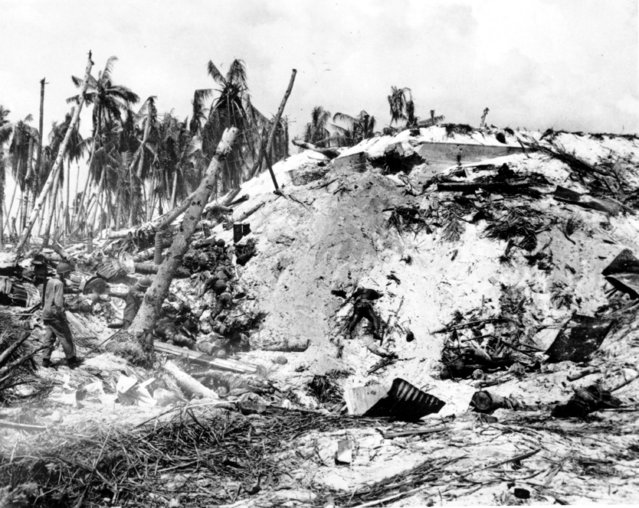
Dead Japanese soldiers lay scattered around a blasted Japanese pillbox at Tarawa Island in the South Pacific on November 11, 1943 during World War II. A bloody battle ensued after the U.S.Marines invaded the Japanese occupied atoll. This photo by Frank Filan won the Pulitzer Prize in 1944. (Photo by Frank Filan/AP Photo)
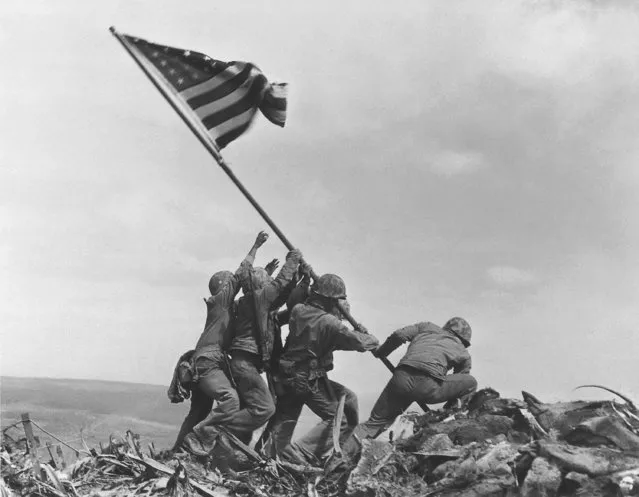
U.S. Marines of the 28th Regiment, 5th Division, raise the American flag atop Mt. Suribachi, Iwo Jima, on February 23, 1945. Strategically located only 660 miles from Tokyo, the Pacific island became the site of one of the bloodiest, most famous battles of World War II against Japan. This iconic photo won Joe Rosenthal the Prize in 1945. (Photo by Joe Rosenthal/AP Photo)
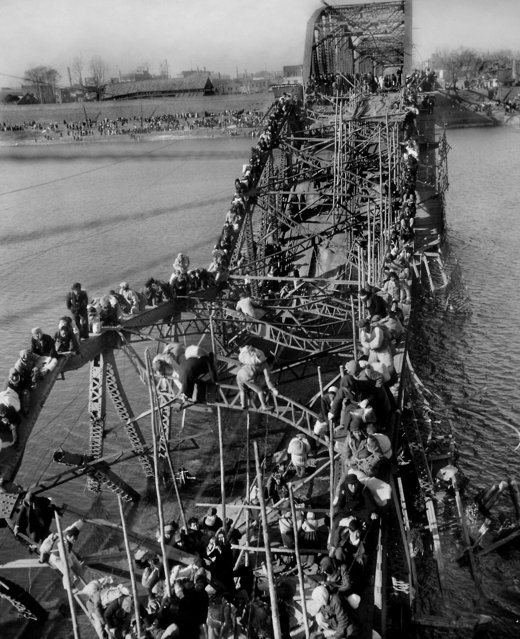
Residents from Pyongyang, North Korea, and refugees from other areas crawl perilously over shattered girders of the city's bridge on December 4, 1950, as they flee south across the Taedong River to escape the advance of Chinese Communist troops. The Chinese entered the Korean War as allies of North Korea. U.S. troops battled on the side of South Korea. Begun in June 25, 1950, the war ended on July 27, 1953, with a military demarcation line set near the 38th parallel where it started. Korea remains divided. This photo by Max Desfor won the Prize in 1951. (Photo by Max Desfor/AP Photo)
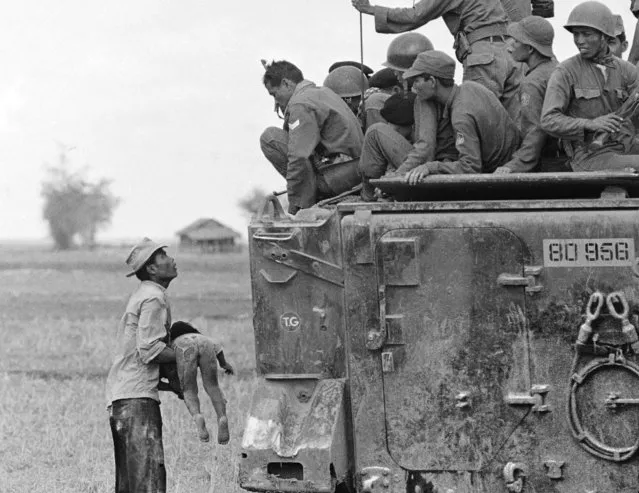
A father holds the body of his child as South Vietnamese Army Rangers look down from their armored vehicle March 19, 1964. The child was killed as government forces pursued guerrillas into a village near the Cambodian border. This photo won Faas the Pulitzer Prize for Photography in 1965. (Photo by Horst Faas/AP Photo)
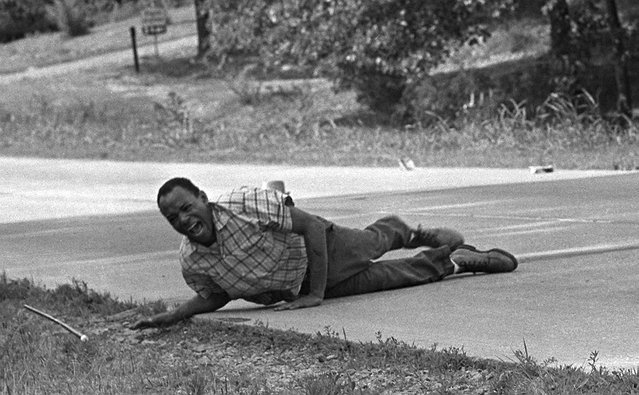
Civil rights activist James Meredith grimaces in pain as he pulls himself across Highway 51 after being shot in Hernando, Miss., June 6, 1966. Meredith was leading the March Against Fear to encourage African Americans to exercise their voting rights when he was shot. He completed the march from Memphis, Tenn., to Jackson, Miss., after treatment of his wounds. This photo won in 1967. (Photo by Jack Thornell/AP Photo)
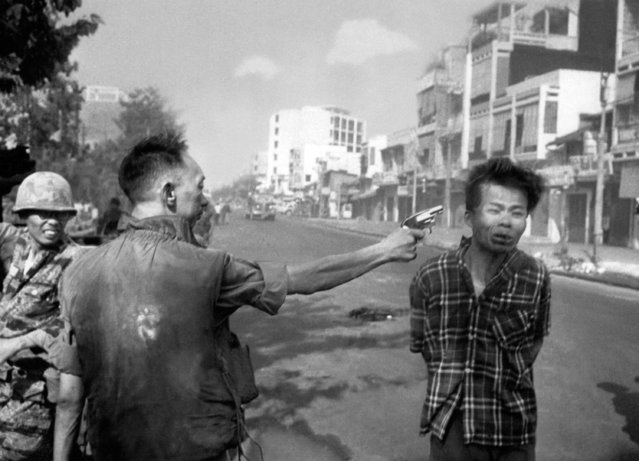
South Vietnamese Gen. Nguyen Ngoc Loan, chief of the national police, fires his pistol, shoots, executes into the head of suspected Viet Cong officer Nguyen Van Lem (also known as Bay Lop) on a Saigon street February 1, 1968, early in the Tet Offensive. This picture won legendary photojournalist Eddie Adams the Pulitzer Prize in 1969. (Photo by Eddie Adams/AP Photo)
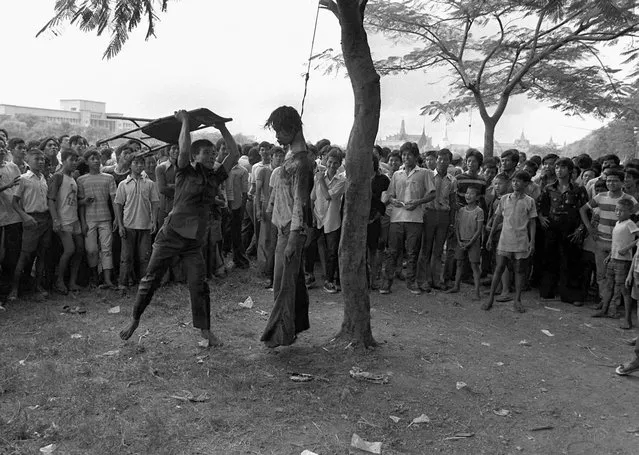
A member of a Thai political faction strikes at the lifeless body of a hanged student outside Thammasat University in Bangkok October 6, 1976. Police stormed the university after students demanded expulsion of a former military ruler and barricaded themselves in the school. The picture won the Pulitzer Prize in 1977. (Photo by Neal Ulevich/AP Photo)
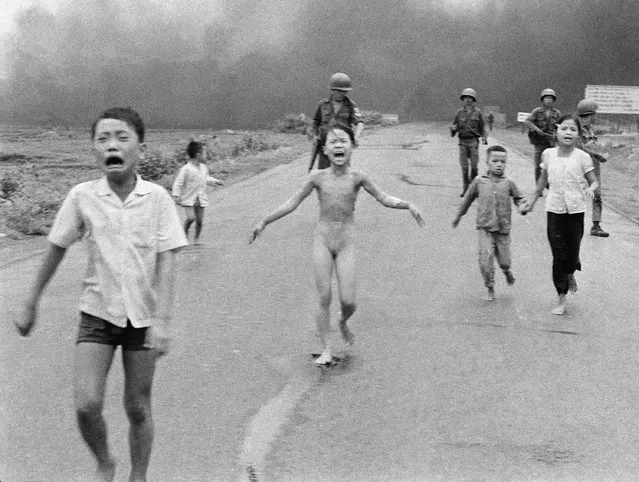
South Vietnamese forces follow after terrified children, including 9-year-old Kim Phuc, center, as they run down Route 1 near Trang Bang after an aerial napalm attack on suspected Viet Cong hiding places on June 8, 1972. A South Vietnamese plane accidentally dropped its flaming napalm on South Vietnamese troops and civilians. The terrified girl had ripped off her burning clothes while fleeing. The children from left to right are: Phan Thanh Tam, younger brother of Kim Phuc, who lost an eye, Phan Thanh Phouc, youngest brother of Kim Phuc, Kim Phuc, and Kim's cousins Ho Van Bon, and Ho Thi Ting. Behind them are soldiers of the Vietnam Army 25th Division. This photo, taken by Vietnamese-born war photographer Nick Ut, won the Prize in 1973. (Photo by Nick Ut/AP Photo)
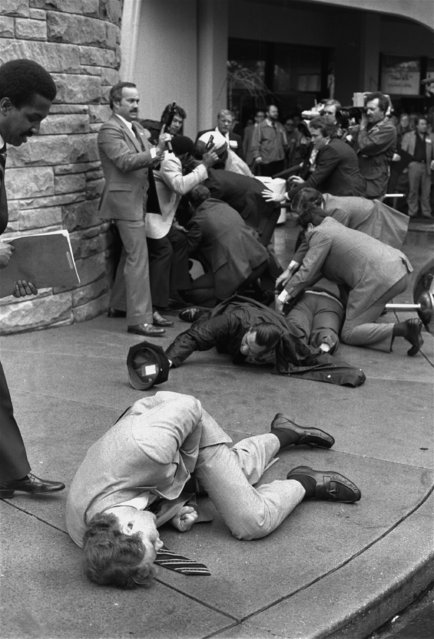
Secret Service agent Timothy J. McCarthy, foreground, Washington policeman, Thomas K. Delehanty, center, and presidential press secretary James Brady, background, lie wounded on a street outside a Washington hotel after shots were fired at U.S. President Reagan on March 30, 1981. McCarthy threw himself into the line of fire and Delehanty, on crowd control duty, was standing close to the gunman, John Warnock Hinckley, Jr., who pushed a pistol through a cluster of bystanders and fired six shots. (Photo by Ron Edmonds/AP Photo)
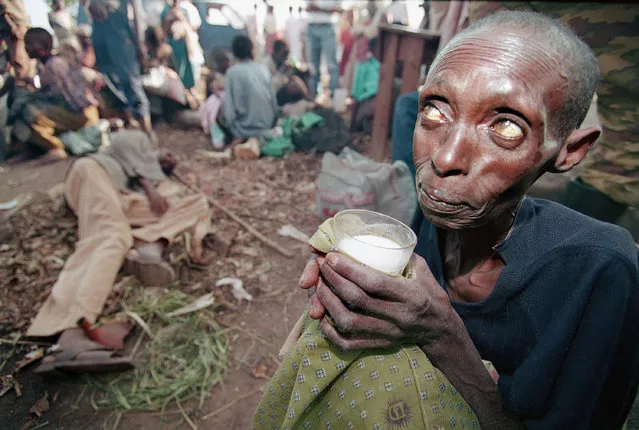
A starving woman sips milk at a makeshift health clinic in Ruhango, 30 miles southwest of Kigali, Rwanda, Monday, June 6, 1994. Thousands of civilians caught in the fighting between government troops and the Rwanda Patriotic Front rebels have taken refuge in Ruhango, but have no access to sufficient medial care. Doctors say 20 to 25 people die every day in Ruhango from disease and hunger. This photo, part of a larger portfolio, won the Associated Press the Pulitzer Prize for Feature Photography. (Photo by Jean-Marc Bouju/AP Photo)
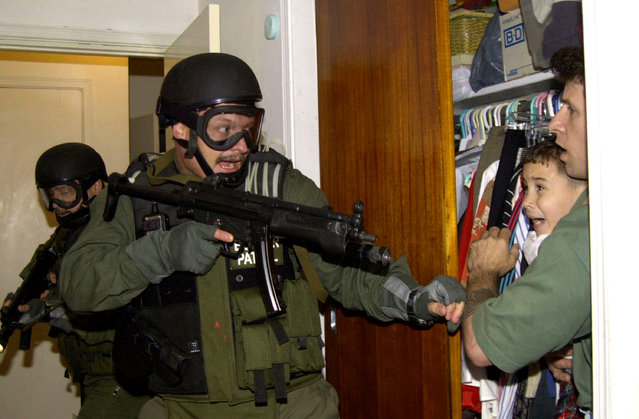
In this third of seven sequential photos, Elian Gonzalez is held in a closet by Donato Dalrymple, one of the two men who rescued the boy from the ocean, right, as government officials search the home of Lazaro Gonzalez for the young boy, early morning, April 22, 2000, in Miami, Florida. Armed federal agents seized Elian Gonzalez from the home of his Miami relatives before dawn, firing tear gas into an angry crowd as they left the scene with the weeping 6-year-old boy. This photo won the Prize in 2001. (Photo by Alan Diaz/AP Photo)
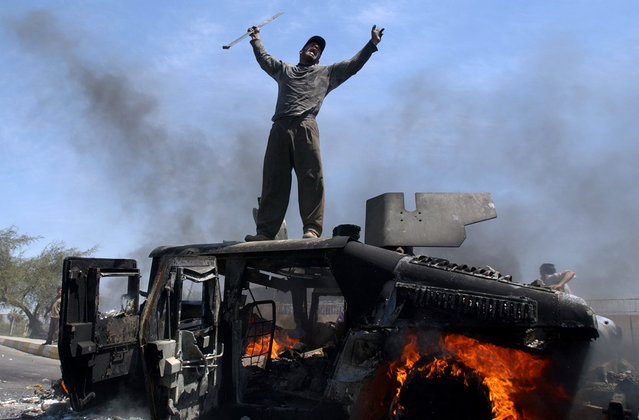
An Iraqi man celebrates atop of a burning U.S. Army Humvee in the northern part of Baghdad, Iraq, Monday, April 26, 2004. An explosion leveled a building in northern Baghdad on Monday, setting four U.S. Humvees nearby on fire. At least one U.S. soldier and several Iraqis were wounded. The cause of the explosion was not immediately known. This photograph is one in a portfolio of twenty taken by eleven different Associated Press photographers throughout 2004 in Iraq. The Associated Press won a Pulitzer prize in breaking news photography for the series of pictures of bloody combat in Iraq. The award was the AP's 48th Pulitzer. (Photo by Muhammed Muheisen/AP Photo)
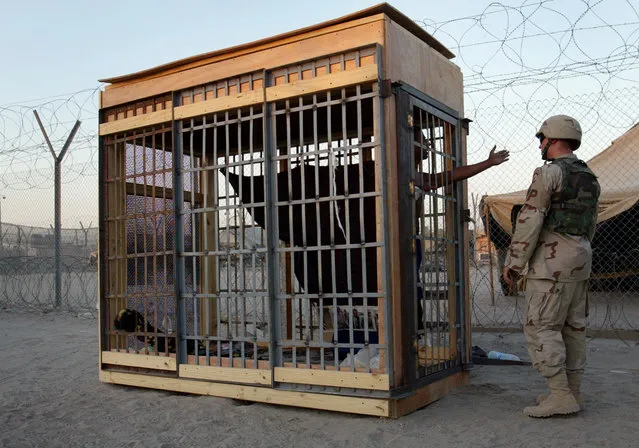
A detainee in an outdoor solitary confinement cell talks with a military policeman at the Abu Ghraib prison on the outskirts of Baghdad, Iraq Tuesday, June 22, 2004. The American soldiers said that he had repeatedly got into fights with other inmates in the prison.This photograph is one in a portfolio of twenty taken by eleven different Associated Press photographers throughout 2004 in Iraq. The Associated Press won a Pulitzer prize in breaking news photography for the series of pictures of bloody combat in Iraq. The award was the AP's 48th Pulitzer. (Photo by John Moore/AP Photo)

A Jewish settler struggles with an Israeli security officer during clashes that erupted as authorities evacuated the West Bank settlement outpost of Amona, east of the Palestinian town of Ramallah, in this February 1, 2006, file photo. Oded Balilty of The Associated Press has won the Pulitzer Prize for breaking news photography for his image of a lone Jewish woman defying Israeli security forces as they remove illegal settlers in the West Bank. (Photo by Oded Balilty/AP Photo)
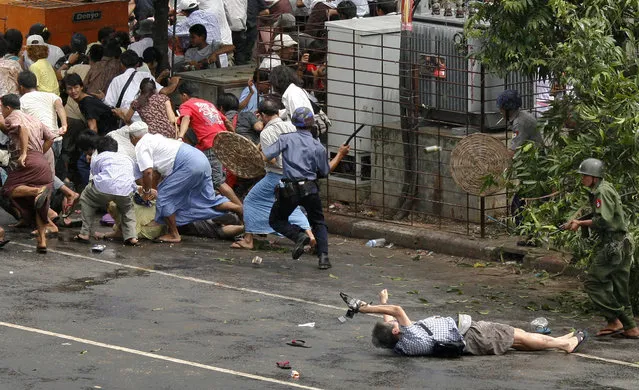
Reuters won the Pulitzer Prize for breaking news photography for a picture of a Japanese videographer killed during a demonstration in Myanmar. Adrees Latif won for “his dramatic photograph of the Japanese videographer, sprawled on the pavement, fatally wounded during a street demonstration in Myanmar”, the Pulitzer Prize board said. Kenji Nagai of APF tries to take photographs as he lies injured after police and military officials fired upon and then charged at protesters in Yangon's city centre September 27, 2007. Nagai, 50, a Japanese video journalist, was shot by soldiers as they fired to disperse the crowd. Nagai later died. (Photo by Adrees Latif/Reuters)
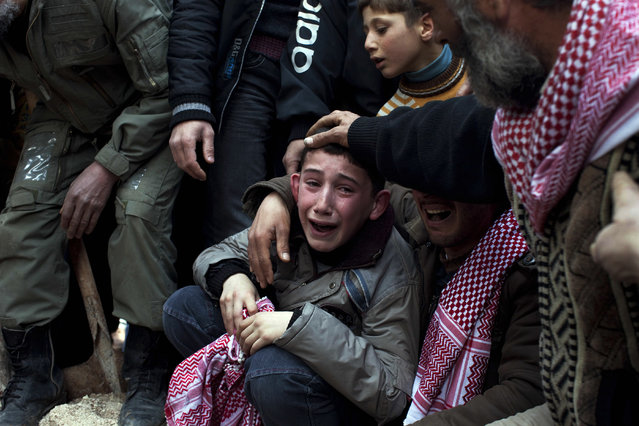
A boy named Ahmed mourns his father, Abdulaziz Abu Ahmed Khrer, who was killed by a Syrian army sniper, during his funeral in Idlib, northern Syria, March 8, 2012. This image was one in a series of 20 by AP photographers that won the 2013 Pulitzer Prize in Breaking News Photography. (Photo by Rodrigo Abd/AP Photo)
22 Aug 2014 12:18:00,
post received
0 comments
